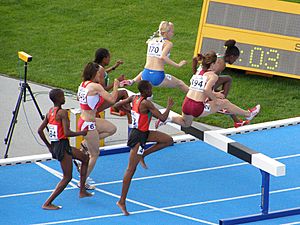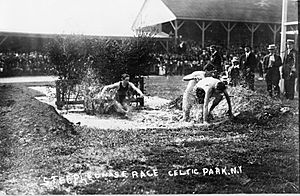Steeplechase (athletics) facts for kids
The steeplechase is an exciting obstacle race in track and field. It gets its name from horse races where riders jumped over obstacles between church steeples. The most common race distance is the 3000 metres steeplechase. Sometimes, a 2000 metres steeplechase is also run. In early Olympics, there were different distances like 2500 meters and 4000 meters. A shorter 1000-meter race is sometimes used for younger athletes.
Contents
History of Steeplechase
The steeplechase race began in Ireland. Horse riders would race from one town's church steeple to the next. They used the steeples as markers because they could be seen from far away. Along the way, riders had to jump over streams and low stone walls.
The modern track and field event started at the University of Oxford in 1860. It was first a cross-country race about two-mile (3.2 km) long. In 1865, it changed to a race with barriers on a flat field. This became the steeplechase we know today.
Steeplechase at the Olympics
The steeplechase has been an Olympic event since the first modern Olympics. The race distance has changed over time. Since the 1968 Summer Olympics, Kenyan athletes have been very strong in the steeplechase. They have won every gold medal since 1984. They even won all three medals (gold, silver, and bronze) in 1992 and 2004.
Women's Steeplechase

The steeplechase for women is 3,000 meters long. The barriers are a bit lower than for men. Before this, they tried a 2,000-meter race with a shorter water jump. The 3,000-meter women's steeplechase first appeared at a major event in 2005. This was at the World Championships in Helsinki. In 2008, women's 3,000-meter steeplechase became an Olympic event for the first time. This happened at the Beijing Olympics.
Other Race Distances
Other groups, like masters athletics (for older athletes) and youth athletics, often run 2,000-meter races. In a 2,000-meter steeplechase, the first two barriers of the first lap are removed.
Race Format
A 3,000-meter steeplechase race has 28 barriers and seven water jumps. A 2,000-meter steeplechase has 18 barriers and five water jumps.
The water jump is never on the main oval part of the track. It is placed either inside or outside the turn. This makes the lap slightly shorter or longer than a regular 400-meter lap. The starting line for the race is moved to make up for this difference in lap length. This ensures the total race distance is correct.
Related pages
- Sprint
- Middle distance race
- Walking race
- Hurdle race
- Relay
- Long distance race
- Cross-country race
- Marathon
Images for kids
See also
 In Spanish: Carrera con obstáculos para niños
In Spanish: Carrera con obstáculos para niños




